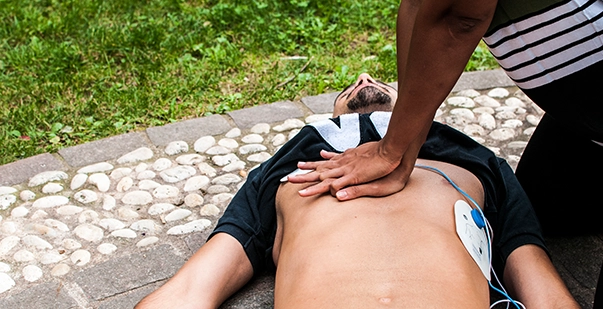When the heart stops beating it leads to an abrupt stop in blood flow to the body and other vital organs. This condition can happen due to several reasons, including a faulty electrical system in the heart, severe trauma and certain medical conditions.
From over 356,000 people experiencing cardiac arrest in the US annually, only 20% recover. Your body will certainly exhibit symptoms in cases of poor cardiac health. It is important to closely observe such symptoms, as without immediate intervention, cardiac arrest can be fatal in minutes.
By the end of this article, you will successfully recognize cardiac arrest risk factors, symptoms to look out for and effective treatment options.
What are the risk factors for Cardiac Arrest?
Cardiac arrests can happen anytime and anywhere. Even a perfectly healthy person might unexpectedly suffer a mild and silent cardiac arrest. Hence, it is important to take notes of the key factors. Below mentioned are the risk factors primarily associated with cardiac arrest-
- Heart Conditions: Existing heart conditions such as coronary artery disease, heart attack (myocardial infarction), heart failure, and congenital heart defects can elevate the risk of cardiac arrest.
Read More: Know the common symptoms of heart attack in women.
- Family History: A family history of cardiac arrest, heart disease, or sudden cardiac death may indicate a genetic predisposition to heart-related issues.
- Age: Advancing age increases the likelihood of developing cardiovascular problems, contributing to the risk of cardiac arrest.
- Gender: Men are generally at higher risk of cardiac arrest compared to women, although the risk for women increases after menopause.
- Lifestyle Factors: Unhealthy habits such as smoking, excessive alcohol consumption, a sedentary lifestyle, and a poor diet high in saturated fats and cholesterol can raise the risk of heart disease and cardiac arrest.
- Obesity: Being overweight or obese strains the heart and increases the risk of developing conditions like high blood pressure, diabetes, and high cholesterol, all of which contribute to cardiac arrest risk.
- Drug Use: Illicit drugs such as cocaine and methamphetamine, as well as certain prescription medications, can trigger irregular heart rhythms and increase the risk of cardiac arrest.
- Electrolyte Imbalance: Abnormal levels of electrolytes like potassium, magnesium, and calcium in the blood can disrupt the heart’s electrical activity, potentially leading to cardiac arrest.
- Prior Episodes: Surviving a previous cardiac arrest or experiencing episodes of arrhythmias increases the likelihood of future incidents if underlying issues are not addressed.
Read More: Know how to deal with death after administering CPR.
What are the signs of Cardiac Arrest?
Recognizing the signs of cardiac arrest is crucial as it enables timely intervention. In most cases cardiac arrest occurs all of a sudden, without any warning. Here’s an overview of the signs to be aware of-
- Chest Discomfort: This may include pressure, squeezing, fullness, or pain in the center of the chest that lasts for more than a few minutes or goes away and comes back.
- Shortness of Breath: Suddenly feeling breathless or experiencing difficulty breathing, even when at rest or during minimal physical exertion.
- Dizziness or Lightheadedness: Feeling faint, dizzy, or lightheaded can be a warning sign of inadequate blood flow to the brain, which may precede cardiac arrest.
- Nausea or Vomiting: Persistent nausea or vomiting, especially when accompanied by other symptoms such as chest discomfort, can indicate heart problems.
- Sudden Loss of Consciousness: Without warning, the person may collapse and lose consciousness, indicating the onset of cardiac arrest.
- No Pulse or Breathing: Upon collapse, the individual may not have a detectable pulse or be breathing, confirming the occurrence of cardiac arrest.
Read More: Know the difference between rescue breathing VS CPR.
What are the immediate steps to follow after a person suffers cardiac arrest?
Being prompt and decisive matters the most when it comes to tackling a cardiac arrest emergency. Below mentioned are the series of steps, which when followed can help the victim stay stable till medical help arrives-
- Call for Emergency Assistance: Dial emergency services (e.g., 911) immediately to summon professional help.
- Start CPR (Cardiopulmonary Resuscitation): Begin chest compressions to help circulate oxygen-rich blood throughout the body.
- Use an Automated External Defibrillator (AED): If available, attach and use an AED to deliver an electric shock to the heart, which can help restore its normal rhythm.
- Continue CPR and AED Use: Alternate between chest compressions and AED shocks as instructed by emergency services until help arrives.
- Follow Dispatcher’s Instructions: If you called emergency services, follow any additional instructions provided by the dispatcher to assist the person until professional help arrives.
- Stay Calm and Reassure Bystanders: Keeping a calm demeanor can help reassure bystanders and maintain an organized response to the emergency situation.
Conclusion
Understanding cardiac arrest risk factors ensures optimum heart health and enables necessary treatment when detected with a problem. By recognizing these factors and being aware of the symptoms one can respond decisively and take a proactive step towards recovery.
With the help of education, awareness and swift action, the incidents of sudden cardiac arrests can be reduced significantly. The minimal effort of gaining knowledge from your side, can help save lives, encouraging a safer and prepared community.













